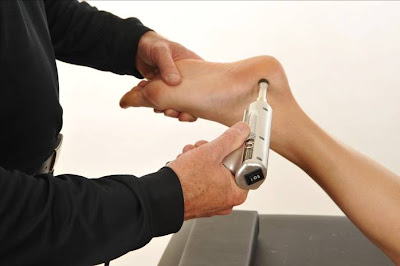Tuesday
Sep142010
Why Instrument Adjusting?
 Tuesday, September 14, 2010 at 2:53AM
Tuesday, September 14, 2010 at 2:53AM Christopher J. Colloca, D.C. CEO and Founder Neuromechanical Innovations
From their benefits of ease of use to providing added safety to a patient encounter, adjusting instruments have provided a new dimension to chiropractic practice. Why all the buzz about Instrument adjusting? Here are the top ten most popular reasons why you should incorporate Instrument adjusting into your practice.
#10. A Mechanical Advantage
From the outset, adjusting instruments were developed to provide the clinician with a mechanical advantage for more efficient chiropractic adjustments.
F = ma
Newton’s Second Law is force equals mass times acceleration. Adjusting instruments take advantage of the acceleration part of the equation in providing large accelerations with a substantially smaller mass. Faster thrusts are associated with the elicitation of neuromuscular reflexes thought to be related to the mechanisms underlying successful treatments (1-3). Instrument adjustment speed also allows you to deliver the thrust faster than the patient’s natural tendency to tighten up and resist the adjustment.
σ = f/a
Stress is another consideration among the mechanical advantages of instrument adjusting. In continuum mechanics, stress is a measure of the average amount of force exerted per unit area, where stress equals force divided by area. Adjusting instruments can achieve an appreciable stress to the spine, while keeping the forces relatively low due to their small contact area with the patient. Appreciating these physics concepts helps to explain how similar amounts of intersegmental bone movement can be achieved with instrument adjusting as manual techniques (4-5).
#9. Safety
Chiropractic adjustments are extremely safe. Still, there are instances where you may have a concern of manually adjusting a particular patient. For instance, you may not want to provide higher forces of manual adjustments to an elderly patient with osteoporosis. Likewise, you may not impart rotatory cervical spine adjustments to a patient with dizziness or signs of cerebrovascular disease. Instrument adjusting enables you to administer care with peace of mind in some situations that you may feel uncomfortable applying manual techniques.

#8. Easy Incorporation Into Your Existing Technique
Instrument adjusting can be easily incorporated into your existing technique repertoire. You may want to adjust the upper cervical spine and TMJ of a headache patient with an instrument, yet perform manual methods on their thoracic and lumbar spine. Alternatively, you may want to adjust the shoulder in a rotator cuff syndrome patient with an instrument instead of using a drop piece.
#7. Evidence-Based Care
A number of studies have investigated instrument adjusting for its effectiveness and have found it to be equivocal to manual adjusting techniques (6). In a number of clinical trials instrument adjusting fared just as well as manual adjusting techniques in reducing pain and improving function (7-11). Ongoing research into the basic science and clinical study of instrument has quantified vertebral motions, and neurophysiological responses associated with instrument adjusting (12-13). Providing evidence-based care is important for your own self-confidence, as well as the confidence of your patients.
 #6. Increase The Range of Patients You Care For
#6. Increase The Range of Patients You Care ForInstrument adjusting allows you to care for a broader range of patients. The low force setting of the Impulse Adjusting Instrument® makes adjustments easier for pediatric adjusting and managing children. Instrument adjusting also enables you to care for patients in their senior years. With the aging of the baby-boomer population, more and more seniors will be seeking care, and using a technique that is well suited for them is important in the growth and sustainability of your practice.
#5. Expand The Range of Services You Provide
Perhaps you currently don’t adjust the feet of patients with plantar fasciitis. Maybe you have been concentrating on the spine and don’t do much with extremity adjusting, or patients with anterior rib pain, TMJ dysfunction, shoulder problems, and the list goes on. Incorporating instrument adjusting into your practice allows you to care for a broader range of conditions and will create a buzz among your patients and in your community.

#4. Adding Technology to Your Practice
It’s a technological age, and adding instrument adjusting into your practice gives a feeling of technology in the practice. Explain to your patients that the adjusting instrument that you are about to use is much faster than you can adjust them manually with your hands and that you can target just the right areas specifically with the tip of the stylus. Your patients will be impressed with your choice to stay current with the times by adding technology to help them heal.
#3. Easier on the Patient
Because of the extreme speed and lower forces generated with instrument adjusting, the adjustments are easier on the patient. This equates with less side-effects, such as muscle soreness, and increased pain during the adjustment or afterwards. Adjustments which are easier on the patient increase patient satisfaction, compliance and patients’ willingness to refer others.
#2. Speed up Your Adjusting Time
Many times I’m asked what I think about a particular soft-tissue technique that takes 20-30 minutes to administer. My response is, “I think it’s great, but you had better be charging $150 a visit for your time.” With instrument adjusting you can achieve the same, if not better, clinical results while speeding up the time it takes for you to provide care.
#1. Easier on You
The number one benefit of instrument adjusting just may be prolonging your practice career. Chiropractors come to us who have hurt their own backs, wrists and shoulders from years of manual adjusting. Others have had carpal tunnel problems and even surgery themselves from pulling a spring-loaded adjusting instrument for years. Decrease the risk of injuring yourself and prolong your practice career with instrument adjusting.
*References and more information on Instrument Adjusting can be found at www.neuromechanical.com
 CBP Seminars | Comments Off |
CBP Seminars | Comments Off | 


